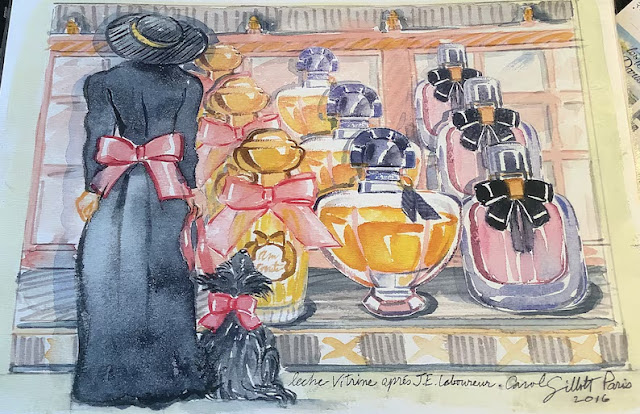It would be difficult to visit Paris & not visit Les Grands Magasins.
I was browsing Paris Forever and was smitten with the background story on Emil Zola. Consumed with the development and innovation of the first big department stores like Le Bon Marche of the Second Empire, Zola built a novel around them, Au Bonheur des Dames/The Ladies Paradise.
The novel is focused on Denise, an orphaned, poor, young country girl who moves to the big city, becomes a shop assistant in the department store, and ultimately wins the heart of the owner of the store bla bla bla.
Many intriguing back stories within this poor girl-meets-rich boy tale that reveal much about the early days of the Second Empire, when Baron Haussmann was changing the face of Paris.
Le Bon Marche became the model of all future department stores as we know them. They offered workers some benefits like free lunches (but they had to sit at the same spot daily). The women could lose their jobs instantly in hard times and often had to take to the streets till they were rehired.
Retail trade changed dramatically with the coming of big emporiums.
The vast variety of products offered all in one place was a huge asset.
Prices were fixed unlike previously in the small boutiques.
Illustrated catalogs were provided so shoppers could plan and dream.
Everything was provided to make women comfortable and happy to keep them inside the store including the first ladies tea salons.
Mirroring Zola's imagined tale of love in a department store, real-life Ernest Cognacq, while working at Le Bon Marche married dress assistant Louise Jay. Together they went off to create La Samaritaine. In the Marais, Musee Cognacq-Jay is the result of their accumulated riches. Department stores Printemps(founded in 1865, by Jules Jaluzot and Jean-Alfred Duclos) and Galeries Lafayette(founded in 1893, two cousins, Théophile Bader and Alphonse Kahn) were soon to follow along with Macy's, Harrod's.
Zola's Au Bonheur des Dames will fill you in on the inner workings behind the doors of the grand magasine you have thrown money at. He touches on many social issues of the time: the rise of a consumer culture and the changing role of women. A fascinating read, especially the detailed historical introduction.
Zola's Au Bonheur des Dames will fill you in on the inner workings behind the doors of the grand magasine you have thrown money at. He touches on many social issues of the time: the rise of a consumer culture and the changing role of women. A fascinating read, especially the detailed historical introduction.
Do look in my Etsy shop for amusing prints & watercolors mailed from Paris 📮


.jpg)
.JPG)
.jpg)
.jpg)

.jpg)
.JPG)
.JPG)
.JPG)
.JPG)

.jpg)





















Bonjour, Paris!
ReplyDeleteFascinating behind the scenes and historical information, Carol!
I shall order the book.
A wonderful weekend to you,
Merisi
Honestly Merisi I was surprised to be so drawn into a Zola book but it's all about us...women's obsessions.
ReplyDeleteAnd there I thought I was finished with Zola .... ;-)
DeleteI love that book! It's so old Paris, definately a must read :)
ReplyDeletegreat research and wonderful summarizing for a glimpse of the origins of retail!
ReplyDeleteWould just love to go to Les Grands Magasins, Carol .....looks fabulous !!
ReplyDeleteThere is also Le Bonheur des Dames in La Viaduc des Arts...an amazing shop if you like needle arts and items that surround them. Delight, delight the whole message of Paris...
ReplyDeleteShould you ever visit Lisbon, Portugal, do take a stroll around Chiado where you can see the old facade of a former perfume shop named... you guessed! Au Bonheur des Dames (photo here at Wikipedia).
ReplyDeleteIt was even featured in an early forties Portuguese movie where the hero worked in the department store next door and was in love with the shopgirl from the perfume shop :-)
Unfortunately while well preserved, it's no longer a perfume shop but a part of a Nespresso store... such is our modern world!
Muinto obrigada patuxxa for the equisite photo reference!
DeleteI must come to Lisbon.
Rio isn't enough :)
Oh, I love the idea of this book. It's a shame that Amazon is charging so much for a public domain book!
ReplyDeleteJ'adore your lovely blog.
~cg
Blame it on Penquin but you can get it in French for $.99 for the Kindle.
DeleteWonderful blog today.
ReplyDeleteI don't know this book but will look for it.
Annie
The introduction is fascinating French history at least in the English version - makes you want to read the whole Zola series(10 books in all)
DeleteGreat history lesson.
ReplyDeleteGreat story and great collection of photos and illustrations!
ReplyDeleteEnjoy the weekend!
Will look for this...only familiar with Germinal(twice read during my idealistic youth and oddly thanks to Vincent Van Gogh) and Therese Raquin...Thanks!
ReplyDeleteWho knew? Finally, something the Chinese did not invent! And what a brilliant idea!
ReplyDeleteI also highly recommend Lady's Paradise (English title) which was required reading in a class I took several years ago at the University of California, Berkeley. The great late Susanna Barrows taught the History of Paris (as well as Modern France). Visit the very top floor of the Bon Marche and notice the wood floors creaking as you walk.
ReplyDeleteI have never been to the top floor at Le Bon Marche!
DeleteIt's on the top of my list..I want to walk where Zola walked.
Weren't you lucky to get great exposure to French history at university..I'm playing catch-up.
Interesting...thank you Hilevine
DeleteSusanna Burrow's thesis on 'The role of the Parisian cafe in the emergence of modern art' is available online
I forwarded this post about the department stores to our cultural geographer son who replies:
ReplyDeletethis lady writes about modernism, shopping, urban spectacle, public space and women.
This said with admiration.